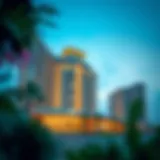Exploring the Unique Charm of Tuscan Residences
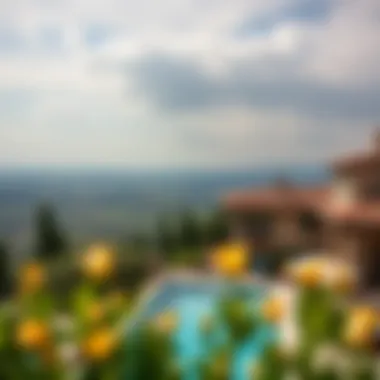
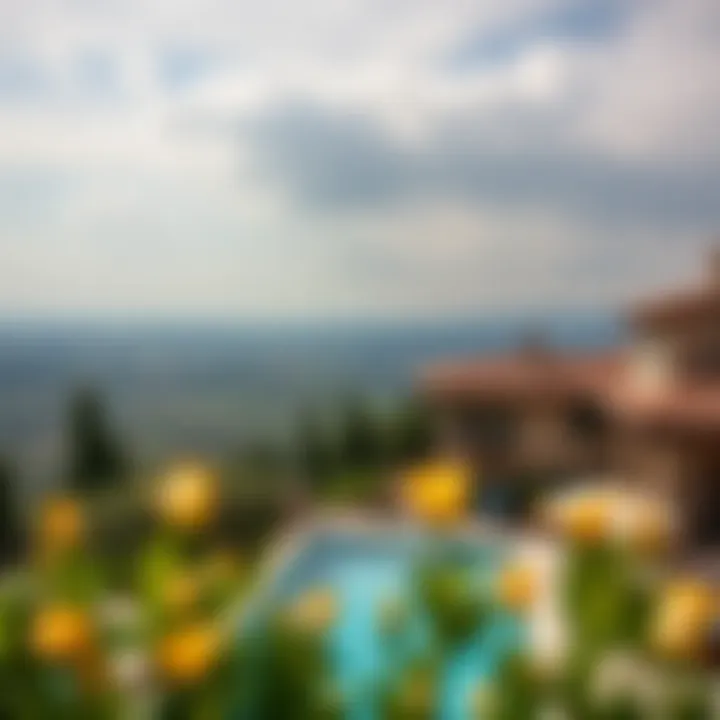
Intro
Tuscan residences are not just simple homes; they represent a rich tapestry of history, culture, and architectural brilliance interwoven with the stunning landscapes of Tuscany. Nestled between rolling hills and vibrant vineyards, these properties serve as a testament to centuries of tradition and artistry that define this region. For potential homeowners, investors, and expatriates, understanding the nuances of Tuscan living opens up possibilities beyond mere ownership.
The journey through this article aims to unearth the characteristics that make Tuscan residences stand out. We'll discuss their distinctive architectural features, explore how they coexist with the enchanting environment, and dissect modern real estate trends that shape the market today. There’s more to these homes than meets the eye, and every brick and beam tells a story worth listening to.
In the upcoming sections, the focus will also shift towards practical aspects of investing in these residences. By examining current property prices, future projections, and identifying high-yield areas, readers can gain a thorough understanding of the Tuscan real estate market dynamics, whether they are aiming to buy a dream home or venture into property investment.
Additionally, tips for first-time investors will round off the discussion, providing actionable insights that can steer potential buyers in the right direction. With that said, let’s dive into the current state of the market.
Market Trends
Current Property Prices
When it comes to the Tuscan property market, prices can vary widely, influenced by location, property type, and unique features of individual homes. For instance, a quaint farmhouse in the heart of Chianti may fetch a different price than a renovated villa near Florence. As of late 2023, average prices for residential properties in Tuscany hover around €3,500 to €5,000 per square meter, depending on proximity to major cities and attractions.
The market has seen a marked increase in demand, especially among foreign buyers looking for their slice of Italian paradise. Cities like Siena and Lucca are becoming particularly popular due to their rich histories and picturesque settings. If you're eyeing the luxury segment, properties boasting historic significance, such as villas dating back to the Renaissance, command premium prices, often exceeding €10,000 per square meter.
Future Projections
Looking ahead, the outlook for Tuscan real estate remains optimistic. Reports suggest a steady growth in property values, driven by an influx of international interest and lifestyle changes post-pandemic. More people, especially retirees and telecommuters, are looking to escape bustling cities, seeking tranquility and a deeper connection with nature in Tuscany.
According to recent studies, the growth forecast for Tuscany’s property market is around 4-6% annually over the next five years. Factors such as infrastructure developments and increasing tourism also contribute to the desirability of the area, making it an attractive destination for investments.
"The unique charm and historical allure of Tuscany makes it a timeless investment opportunity for those who appreciate art and nature simultaneously."
With a clearer picture of the market, turning our attention to investment opportunities can further inform prospective buyers.
Investment Opportunities
High-Yield Areas
Identifying high-yield areas is crucial for anyone looking to invest wisely in Tuscan real estate. Neighborhoods such as Florence, Bologna, and Pisa tend to offer significant returns, primarily due to their popularity among tourists and expatriates. Walnut Hill in Florence, with its artistic vibe and close-knit community, stands out as a prime location.
Moreover, areas that are off the beaten tourist track, like Val d'Orcia, are rising stars. This region, recognized for its breathtaking landscapes, is beginning to attract savvy investors. It’s not just about location; historical elements intertwined with modern comforts go a long way in raising property values.
Tips for Investors
For those considering making an investment, here are a few tips:
- Research Thoroughly: Familiarize yourself with the local market and historical price trends; data is king.
- Engage Local Experts: Having a knowledgeable agent who understands the nuances of the Tuscan property scene can be invaluable.
- Consider Renovation Potential: Properties that may require some TLC can often be secured at lower prices, and with the right touch, they can increase significantly in value.
- Look for Incentives: Many municipalities offer tax benefits or grants for restoring historical properties, which can enhance ROI.
- Be Patient: The real estate market is not a sprint but a marathon. Values could see fluctuations, but long-term trends are favorable.
With insights into market trends and investment opportunities, aspiring buyers and investors are now better equipped to navigate the captivating world of Tuscan residences. The next section will delve into the architectural features that define these unique properties, further enriching the understanding of what makes living in Tuscany a remarkable experience.
Prolusion to Tuscan Residences
Tuscan residences are much more than mere homes; they embody a lifestyle steeped in history, culture, and artistry. This section introduces the essence of Tuscan architecture, offering a foundation for understanding the unique attributes that draw people from all walks of life—investors, homebuyers, expatriates, and more—to the rolling hills and scenic vistas of Tuscany. Through this exploration, we will reveal how these homes reflect a deep connection to the land and the people, emphasizing the architectural choices that are both practical and aesthetic.
The Essence of Tuscan Architecture
Tuscan architecture stands as a testament to the region's rich history and craftsmanship. A fusion of medieval robustness and Renaissance elegance, homes in Tuscany showcase a distinct vernacular style that echoes the natural landscape.
Key elements contributing to its essence include:
- Natural Materials: Homes are often built using locally sourced materials—stone, clay, ochre, and wood—creating a seamless relationship with the surroundings. For instance, the rough-hewn stone walls exude durability and warmth.
- Arched Doorways and Windows: These architectural features not only invite in light but also bestow a sense of charm and character. The characteristic arches provide an inviting entryway, while large windows frame breathtaking views of the countryside, wrapping the exterior beauty into the interior space.
- Terracotta Roofs: The iconic red roofs are not just visually appealing but are also practical. The sloped design allows for rainwater to flow away effectively, reducing the wear on structures and enhancing longevity.
- Courtyards and Loggias: Spaces such as courtyards serve as extensions of indoor living areas, characterized by an open design that allows for ventilation while retaining a sense of privacy. Loggias, often adorned with arches, offer shaded outdoor spaces conducive for relaxation amongst nature.
In essence, Tuscan architecture elegantly marries form and function, embodying a lifestyle inspired by simplicity and communion with nature.
"The beauty of Tuscan homes lies not in their extravagance but in their ability to summon the gentle whisper of the rolling hills and the rich aromas from the vineyards nearby."
This understanding of Tuscan architecture is crucial as it sets the stage for our journey through the historical context, architectural features, and lifestyle that these homes promote. By appreciating the essence of these residences, one can better interpret the significance they hold today—not just as fine properties, but as symbols of a vibrant cultural heritage.
Historical Background
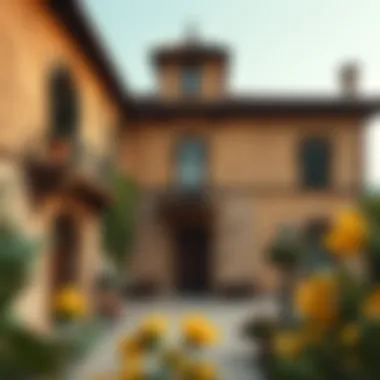

Understanding the historical background of Tuscan residences is crucial for grasping their architectural richness and cultural significance. This context not only offers insights into how these homes have adapted over centuries but also showcases the interplay between design and the evolution of the Tuscan landscape. Acknowledging the historical threads running through these residences helps to appreciate their aesthetic value and invites present-day investors or homeowners to engage in a narrative that stretches back in time.
Origins of Tuscan Design
The origins of Tuscan design can be traced back to the early days of the region’s history, where the influence of the Romans laid the groundwork for architectural concepts that would flourish in the Renaissance. In the remote hill towns and pastoral settings, materials such as terracotta, stone, and timber were favored, drawing from local resources to create structures that harmonized with their settings. These homes were not just functional shelters; they represented a lifestyle deeply connected to the agricultural rhythm of Tuscany.
A vital aspect was the incorporation of open spaces—courtyards and gardens—allowing light and nature to penetrate the built environment. This integration encouraged communal living and interaction, which remain significant even in modern adaptations of Tuscan residences.
When examining Tuscan homes today, one can still observe these early influences. The charming facades, often characterized by arched doorways and simple yet sturdy outlines, echo this rich history. Such elements resonate with those seeking homes that not only reflect personal taste but also the stories embedded within their walls.
Evolution Through the Ages
Tuscany's architectural evolution is a tapestry that features various styles, each layer adding complexity to the region's aesthetic identity. The Middle Ages brought fortified structures, reflecting the need for defense in a turbulent period. It was during the Renaissance, however, that Tuscan architecture truly found its footing.
Among the notable features from this era was the use of symmetry and proportion, developing into an iconic architectural language that would influence homes in Tuscany and beyond. The Palazzos built by affluent families exhibit this grandeur, constructed with an attention to detail and an emphasis on showcasing wealth through artistry.
Subsequent periods saw the baroque and neoclassical styles subtly influencing Tuscan designs, pushing the envelope of traditional forms while still being grounded in the original Tuscan ethos. This adaptability is what makes Tuscan residences appealing; they preserve traditional values while adapting gracefully to more modern needs.
Today, the combination of historical reverence and modern functionality can be seen in many restored villas and farmhouse conversions, capturing the hearts of both locals and expatriates alike.
Culmination
In essence, the historical background of Tuscan residences forms the backbone of their allure. By interweaving the origins of design with their evolution, one comprehends how these homes speak volumes about Tuscany's heritage. The past not only influences current trends in architecture but serves as a reminder of the timelessness of good design, making Tuscan residences a compelling investment for investors, agents, homebuyers, expats, and developers alike.
Architectural Features of Tuscan Homes
Understanding the architectural features of Tuscan homes is absolutely vital when exploring the charm and appeal of these residences. Each element reflects the region's rich history and unique cultural identity. The way these homes are designed speaks volumes about their practicality and aesthetic beauty, and their integration into the surrounding landscape is nothing short of remarkable.
Materials and Construction Techniques
When it comes to materials, Tuscan homes are known for using local resources, fostering a sense of authenticity and sustainability. Traditional homes often utilize stone—like the iconic sandstone known as pietra serena—which gives the structures a sturdy foundation and a weathered beauty that ages gracefully. In addition, terracotta tiles serve as roofs, their warm hues contrasting beautifully against the backdrop of the vivid Tuscan sky.
Construction techniques also stand out. Many of these homes are built using masonry, a method that has been honed over centuries. The walls are typically thick, designed to keep out the summer heat and retain warmth during winter nights. Insulation isn’t just a modern invention in these parts; it’s inherent to the architecture itself, ensuring a comfortable living environment year-round.
Unique Structural Elements
No discussion about Tuscan homes would be complete without highlighting unique structural elements. Arched doorways and windows are a common feature, embodying the elegance that defines Tuscan architecture. These arches are not only aesthetically pleasing but also provide functional benefits, such as enhanced structural integrity. Additionally, many homes include loggias—open-air galleries covered by a roof. This creates a seamless transition between indoor and outdoor living, which is central to the Tuscan lifestyle.
The use of buttresses and balconies further embellishes these structures, allowing them to rise majestically against the horizon. Such designs reflect the aspirations and artistry of builders from centuries past, who sought not just to house but to create spaces filled with character and warmth.
Integration with the Landscape
Tuscan homes do not merely occupy their surroundings; they become part of them. Their design takes full advantage of the stunning rolling hills, vineyards, and olive groves that characterize this famous region. Homes are often oriented to maximize views, allowing residents to gaze out upon the breathtaking landscapes just beyond their doorsteps. They merge both with nature and the rustic charm of the countryside.
The gardens associated with these homes typically reflect the indigenous flora, featuring cypress trees and blooming lavender that scent the air. Terraced landscapes are favored as they help to integrate the architecture with the hilly terrain effectively. Walkways made of natural stones meander through these gardens, inviting leisurely strolls and a sense of peace. In every aspect—from the choice of materials to the overall layout—Tuscan residences embrace and celebrate their natural environment.
Engaging with the architectural features of Tuscan homes reveals how the past and present coalesce in designs that honor tradition while adapting to contemporary needs.
Interior Design Aspects
The interior design of Tuscan residences speaks volumes about the region's rich culture and historical significance. It's not just about aesthetics; it depicts an entire lifestyle that balances rustic charm with modern convenience. In this section, we will delve into the critical aspects influencing Tuscan interiors, highlighting how color palettes, textiles, furnishings, and decor choices shape the essence of these homes.
Color Palettes and Textiles
Colors play a crucial role in creating the ambiance of a space, and in Tuscan homes, they often reflect the underlying landscape. Warm, earthy tones dominate the palette — think ochres, terracotta, and deep reds. These colors not only mimic the vibrant Italian countryside but also invoke a sense of warmth and comfort.
Textiles further amplify this feeling, with an emphasis on natural materials like linen, cotton, and wool. Fabrics adorned with traditional Tuscan patterns, such as florals or geometric designs, can often be found draping over chairs or framing windows. This style embraces authenticity; using local artisans for craftsmanship ties back to the area's historical roots.
When selecting textiles, consider layering for added depth and texture. For instance, a richly colored tapestry over a neutral sofa creates visual interest and liveliness. Moreover, utilizing natural fibers aids in achieving a rustic yet elegant look that Tuscan design embodies. Incorporating textiles in your home should feel intuitive, reflecting the surroundings while standing the test of time.
Furnishings and Decor
The furnishings in Tuscan residences are deeply rooted in tradition, showcasing locally sourced wood and hand-forged metals, much like the kitchens of old. Heirloom-quality furniture pieces dominate the spaces where families gather. Think robust wooden tables that have weathered decades, adorned with hand-painted tiles — a nod to the artistry found throughout Tuscany.
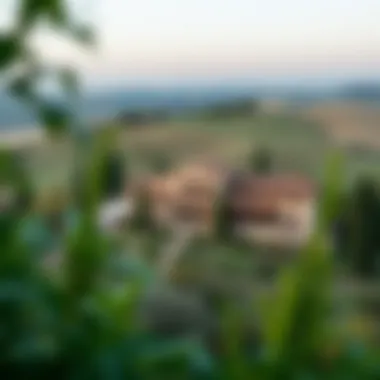
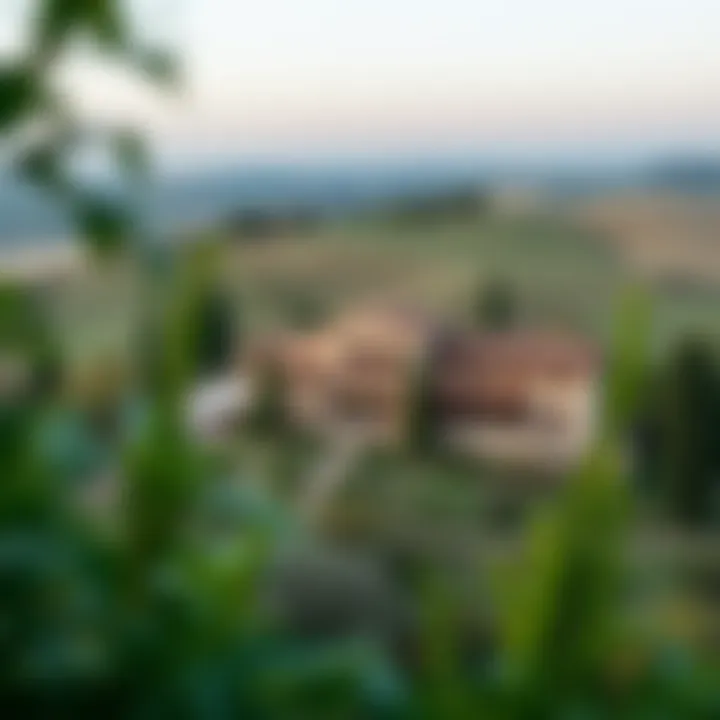
In decor, one can’t overlook the power of simplicity. A carefully placed terracotta vase with fresh flowers can infuse life into a room without being overbearing. Similarly, displaying simple ceramics or vintage finds tells a story of regional craftsmanship and history.
While traditional designs hold significant value, a modern touch can easily be integrated. For example, pairing antique side tables with a contemporary lamp strikes a balance between old and new. This marriage of styles resonates with a large audience, from home buyers looking for charm to investors aiming for a piece of Tuscany’s DNA.
"The beauty of Tuscan design is not just in what you see, but in the stories and memories each piece carries, contributing to a unique living experience."
Ultimately, the interior design aspect of Tuscan residences should invoke peace, coziness, and an appreciation for the land's rich heritage. Investing in the right elements makes a house feel like home while cherishing craftsmanship and history, which is essential for anyone who calls Tuscany home.
The Tuscan Lifestyle
In exploring the allure of Tuscan residences, one cannot overlook the profound impact of the Tuscan lifestyle on the way these homes are perceived and used. Living in Tuscany is more than just residing in a picturesque house; it symbolizes an attitude towards life, emphasizing simplicity, connection to nature, and a deep appreciation for culture and community. This lifestyle creates a framework in which the architecture of Tuscan homes finds its true purpose.
Cultural Influences on Living Spaces
There lies a rich tapestry of cultural nuances that dictate the design and arrangement of living spaces in Tuscany. This cultural backdrop shapes everything from the way interiors are decorated to how outdoor spaces are utilized.
- Artisanal Heritage: Tuscany is renowned for its artisanal craftsmanship. Local artisans create handmade tiles, wrought iron fixtures, and woodwork that reflect the natural beauty surrounding them. This connection with art can be seen in Tuscan homes, where finishes and furnishings often tell a story of skilled craftsmanship passed down through generations.
- Social Interactions: The architecture promotes social connections. Communal spaces, such as large kitchens and dining areas, encourage family gatherings and communal meals. The Italians have a saying: „A tavola non si invecchia,” which means "At the table, one does not grow old." This embodies the spirit of hospitality, where meals bring people together in a shared experience.
- Outdoor Living: Given the stunning landscapes of Tuscany, many homes feature outdoor patios and gardens that reflect the importance of nature. Homes blend seamlessly with the environment to create relaxing havens. This integration encourages a way of life where morning coffee can be enjoyed while gazing at rolling hills or where evening meals can be savored under a starry sky.
- Rural Influences: The traditional farmhouse, or "podere," can be found scattered across the Tuscan countryside. These homes often serve as symbols of a rural lifestyle, with sustainable practices such as vegetable gardening and olive cultivation being integral to daily activities. This focus on self-sufficiency also influences the design of modern residences, with many opting for features such as solar panels and rainwater collection systems.
"Tuscany is not just a place; it's a way of life that combines beauty, function, and deep-rooted traditions."
The interplay between these cultural influences and the living spaces creates an environment where residents aren’t merely surviving but instead thriving. Emphasizing connections—with each other, the land, and the rich culture around them—defines what it means to embrace the Tuscan lifestyle. As potential investors, homebuyers, and expatriates explore the prospect of owning a Tuscan residence, understanding these cultural nuances becomes crucial.
Modern Adaptations of Tuscan Residences
Modern adaptations of Tuscan residences signify a compelling blend of tradition and contemporary innovation. These residences have long been celebrated not only for their classic regional designs but also for their inherent charm and durability. In today's world, where sustainability and functionality are paramount, the evolution of these homes speaks volumes about their capacity to accommodate modern lifestyles while preserving their historical integrity. By delving into the specific elements of design and living that make these adaptations stand out, we can fully appreciate their value in today's real estate landscape.
The growing interest among homebuyers and investors in Tuscan properties illustrates how these adaptations meet contemporary demands. For many, owning a Tuscan home is not merely about having a picturesque dwelling; it’s about the lifestyle and community that come with it. The adaptations often evoke feelings of nostalgia while also being practical for 21st-century living. Features like open floor plans, energy-efficient systems, and state-of-the-art amenities have become key selling points.
"In blending the old with the new, modern adaptations serve as a bridge connecting history with the future, enhancing the life experiences of those who choose them."
Innovative Design Practices
One essential aspect of modern adaptations lies in innovative design practices. Architects and designers are not only tapping into the rich architectural language of Tuscany, but they are also incorporating modern materials and techniques that enhance both comfort and style. The result is a refreshing take on classic aesthetics that appeals to a wide audience, particularly investors and homebuyers looking for unique properties with character.
For instance, many renovations focus on maximizing natural light through large windows and open spaces. This approach helps to create a more inviting atmosphere, aligning perfectly with the Tuscan ethos of blending indoor and outdoor spaces.
Moreover, modern amenities are now seamlessly integrated, offering conveniences such as updated kitchens equipped with high-tech appliances and luxurious bathrooms that boast modern features while maintaining a rustic charm.
Some key characteristics of these innovative design practices include:
- Preservation of original structural elements, like stone walls or terracotta tiles, alongside modern finishes.
- Use of energy-efficient materials to promote sustainability and reduce utility costs.
- Flexible spaces that cater to diverse lifestyle needs, often incorporating home office spaces or leisure areas.
Sustainable Living Solutions
In recent years, sustainable living solutions have gained significant traction in Tuscan residences. The focus on reducing the environmental impact of living has led many homeowners to adopt energy-saving practices and smart technology, which not only benefits the planet but also leads to lower costs over time.
Sustainable features can manifest in various ways, from solar panel installations to rainwater harvesting systems. Incorporating local materials in construction not only supports sustainability but also ensures that homes remain true to their Tuscan roots. By utilizing resources found within the region, homeowners can create residences that harmonize beautifully with their environment.
The benefits of sustainable living in these adapted homes include:
- Reduced energy consumption through the use of modern heating and cooling systems.
- Enhanced property value, as environmentally friendly homes are increasingly sought after in the real estate market.
- A sense of community and responsibility, as many homeowners invest in environmentally-minded projects that uplift their neighborhoods.
Real Estate Trends in Tuscany
The allure of Tuscany extends far beyond its picturesque landscapes and enchanting architecture; it includes a real estate market that is rich in history and ripe with opportunity. For investors, agents, homebuyers, expats, and developers alike, staying informed about real estate trends in Tuscany is essential. The nuances of this market can significantly impact property values and investment strategies. Understanding these trends can lead to better decision-making and potentially lucrative investments.
Market Analysis and Insights
Tuscany's real estate market has experienced a revival in recent years, thanks to a variety of factors.
- Increasing demand from international buyers: Homeownership in Tuscany is not just a local endeavor; it has attracted buyers from around the world. This influx is fueled by a desire for second homes, retirement escapes, or profitable investment properties.
- Urban versus rural appeal: While cities like Florence and Siena remain popular, there's a growing interest in rural areas, where buyers seek serenity and the traditional Tuscan lifestyle. Properties in these regions are often more affordable and can provide a better return on investment.
- Value appreciation: Many analysts predict a steady increase in property values in Tuscany, driven by both local and foreign demand. This makes investing now an attractive consideration.
Moreover, it is worth noting the integration of technology in property transactions has made it easier for potential buyers to explore Tuscany's real estate options. Virtual tours and online listings keep international buyers in the loop about market movements without even stepping foot in Tuscany.
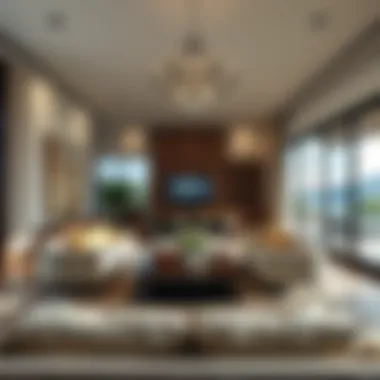
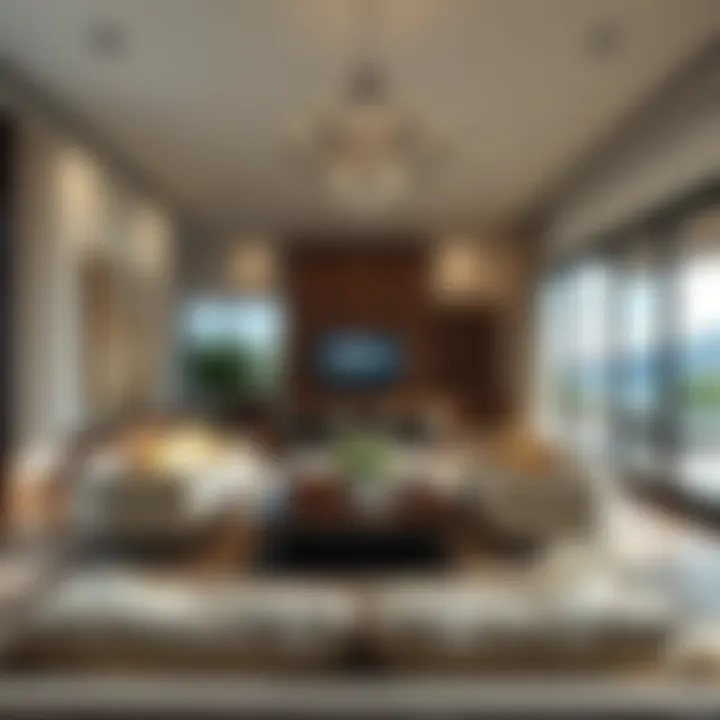
Investment Opportunities
The current landscape offers multiple avenues for investment:
- Renovation Projects: Older properties often come at a lower price compared to new builds. With some TLC, these can be transformed into charming homes or profitable rental units.
- Agrotourism Ventures: The interest in agritourism has spiked, merging hospitality with agriculture. Investors can convert traditional farms into vineyard B&Bs or agritourism experiences.
- Luxury Real Estate: High-end properties—villas with stunning views, historical estates—appeal to affluent buyers. These can command a premium price, especially if situated in prime locations.
As Tuscany continues to hold its charm, the potential for profit remains bright. Investors are not just buying a piece of property but are acquiring a slice of a lifestyle that is centuries old. The unique blend of historical resonance and modern convenience leaves room for innovation and growth in the real estate sector.
"In Tuscany, real estate isn't just about property—it's about history, culture, and a way of life."
By keeping an eye on market trends, understanding the unique dynamics of Tuscany’s real estate, and identifying investment opportunities, investors can find themselves on a fruitful path toward securing not just a property, but a piece of this enchanting region.
Advantages of Owning a Tuscan Residence
Owning a Tuscan residence is about more than just acquiring property; it's about embracing a way of life steeped in historical richness and beauty. This section looks at the significant benefits of owning a home in Tuscany, appealing to investors, homebuyers, and anyone captivated by the charm of the region.
Cultural Heritage and Value
A Tuscan residence is like a time capsule, capturing the spirit of eras past while offering modern comforts. The importance of cultural heritage in Tuscany can't be overstated; these homes serve as a reflection of centuries of art, architecture, and community values. For many, the aesthetic of a classic Tuscan villa evokes a sense of nostalgia and connection to European history.
One of the standout aspects of owning property in this region is the intrinsic value associated with its cultural backdrop. Below are some key elements highlighting the significance of heritage and value:
- Architectural Integrity: Classic Tuscan homes are constructed with locally sourced materials like terracotta and stone, reflecting the environment and history. This authenticity tends to increase property value over time.
- Artistic Influence: The Tuscan landscape has inspired renowned artists and architects throughout history, and owning a home here places one among this rich narrative. It is not just a house but a canvas of culture.
- Proximity to Cultural Hotspots: Many Tuscan residences are located near significant cultural landmarks, historical cities like Florence and Sienna, offering residents an opportunity to immerse themselves in art, food, and tradition every day.
"A home in Tuscany is not just a place but a portal to history and artistry, where each stone tells a story."
Additionally, Tuscany is known for its vibrant lifestyle, characterized by culinary traditions, wine production, and communal festivals that breathe life into the culture. By investing in a Tuscan residence, one’s family can partake in these unique experiences that foster a strong sense of community.
Many potential homeowners also find that living in Tuscany enhances their quality of life. The region's rolling hills, olive groves, and vineyards contribute not only to breathtaking views but to a slower, more conscious way of life—one that values leisure and connection with nature. Therefore, owning a residence in Tuscany is an investment in both property and lifestyle, with an ability to appreciate greatly in value as demand continues to surge.
In summary, the advantages of owning a Tuscan residence extend into both tangible and intangible aspects, making it an appealing choice for investors, homebuyers, and expats alike. This section serves to highlight the rich tapestry of values tied to Tuscan living, ensuring that prospective owners appreciate not just the home itself, but the culture interwoven within it.
Challenges of Tuscan Property Ownership
Owning a piece of Tuscany is often romanticized as a dream of sun-kissed hills and effortless beauty. However, diving into this dream comes with its own set of challenges. It's crucial for potential buyers, be they homebuyers, investors, or developers, to understand that while the allure of a Tuscan residence is undeniable, navigating the complexities of ownership can also be quite tricky.
Regulatory Issues
When it comes to purchasing property in Tuscany, the legal landscape can seem as intricate as the winding streets of Florence. Regulations may vary significantly, depending on the location. Here are a few considerations:
- Property Laws: Different regions may have distinct zoning laws, heritage protections, and building regulations. It's imperative to understand whether the property falls under any constraints like preservation orders that govern how you can renovate or maintain the home.
- Selling Restrictions: If you ever decide to sell your Tuscan property, awareness of local laws concerning property sales is essential. Some zones may prioritize preserving local character over facilitating fast sales.
- Permit Processes: When looking to make changes to your property, the permit processes can be slow and cumbersome. Without careful handling, you might find yourself stuck in bureaucratic limbo. For instance, renovations, swimming pool installations, or even simple landscaping can require various approvals.
"Purchasing a home in Tuscany isn’t just a transaction; it’s an entry into a world with rules and regulations that might not just mimic your home country’s norms."
Being prepared for these regulatory challenges will save you headaches down the line. Engaging local legal experts familiar with Tuscan property law can ease this process significantly.
Maintenance Considerations
Purchasing a Tuscan home means embracing its age and unique character. But with that often comes a hefty wardrobe of maintenance responsibilities.
- Weathering: Tuscan homes, often constructed from local stone or brick, can suffer from the elements. Protecting against moisture, particularly during the rainy season, is paramount. Regular inspections of roofs and foundations can prevent future disasters.
- Landscaping: If your property boasts one of those scenic Tuscan gardens, well, plan on committing time or resources to its upkeep. These verdant spaces require constant care and can be quite resource-intensive, especially under the Mediterranean sun.
- Utilities: Keep in mind that rural properties may not have modern utilities readily available. Whether it's running water or internet access, some might find themselves dealing with outdated systems or no service at all.
All these aspects mean that ownership isn't merely about enjoying a picturesque view; it’s also about engaging in a continuous dialogue with your property. A proactive approach to maintenance can turn potential headaches into manageable tasks, maximizing your enjoyment of the Tuscan lifestyle.
Overall, while owning a residence in Tuscany is undoubtedly appealing, potential buyers must reckon with the unique challenges that come with it. By being aware and thorough, you can navigate through these hurdles with a clearer outlook.
Ending
Reflecting on the unique charm of Tuscan residences, it becomes clear that their allure reaches well beyond mere aesthetic appeal. Owning a property in Tuscany is akin to holding a piece of history, embodying not just bricks and mortar, but a lifestyle deeply rooted in tradition, culture, and the breathtaking landscape of the region.
Reflecting on the Tuscan Experience
Delving into the experience of living in a Tuscan residence encapsulates a holistic journey that blends past and present. For investors, agents, and homebuyers alike, understanding this experience is paramount. Here are some key elements to consider:
- Cultural Heritage: Each home resonates with stories—whether it’s the rustic charm of a farmhouse in Chianti or a luxurious villa overlooking the rolling hills. Living here enriches one's life with the arts and culinary traditions, making everyday moments extraordinary.
- Architectural Beauty: The unique features of Tuscan architecture, such as terracotta tiles, arched windows, and exposed wooden beams, offer a pleasing aesthetic. These elements create a sense of warmth and invitation, which enhances day-to-day living while showcasing a timeless design philosophy.
- Integration with Nature: Tuscany's landscape is a character in its own right. Properties are often thoughtfully nestled within the hills, promoting not just beautiful views but also an energy that connects residents to the rhythms of nature. This connection fosters a unique sense of tranquility absent in more urban settings.
- Modernization within Tradition: As we discussed in earlier sections, the balance of modern living and traditional design is a significant trend. New buyers can find properties that uphold classic aesthetics while integrating the latest in sustainable technology, making for an eco-friendly lifestyle.
- Investment Opportunities: The market in Tuscany continues to draw interest. As culture and tourism flourish, properties here often appreciate in value, making them a sound investment for those looking to make their money work while also enjoying the pleasures of Italian life.
In sum, the Tuscan experience is not merely about owning a residence; it transcends into a way of life rich in history, natural beauty, and community spirit. Embracing this journey requires a thoughtful approach, but the rewards—be they personal fulfillment or financial stability—can be immensely gratifying.
"Owning a piece of Tuscany is not just an investment; it's inviting a legacy into your life."
Ultimately, understanding these facets is essential for anyone aiming to immerse themselves in this beautiful region. With careful consideration and passion, one can unlock the true essence of Tuscany’s residences, ultimately enriching both one’s life and investment portfolio.






